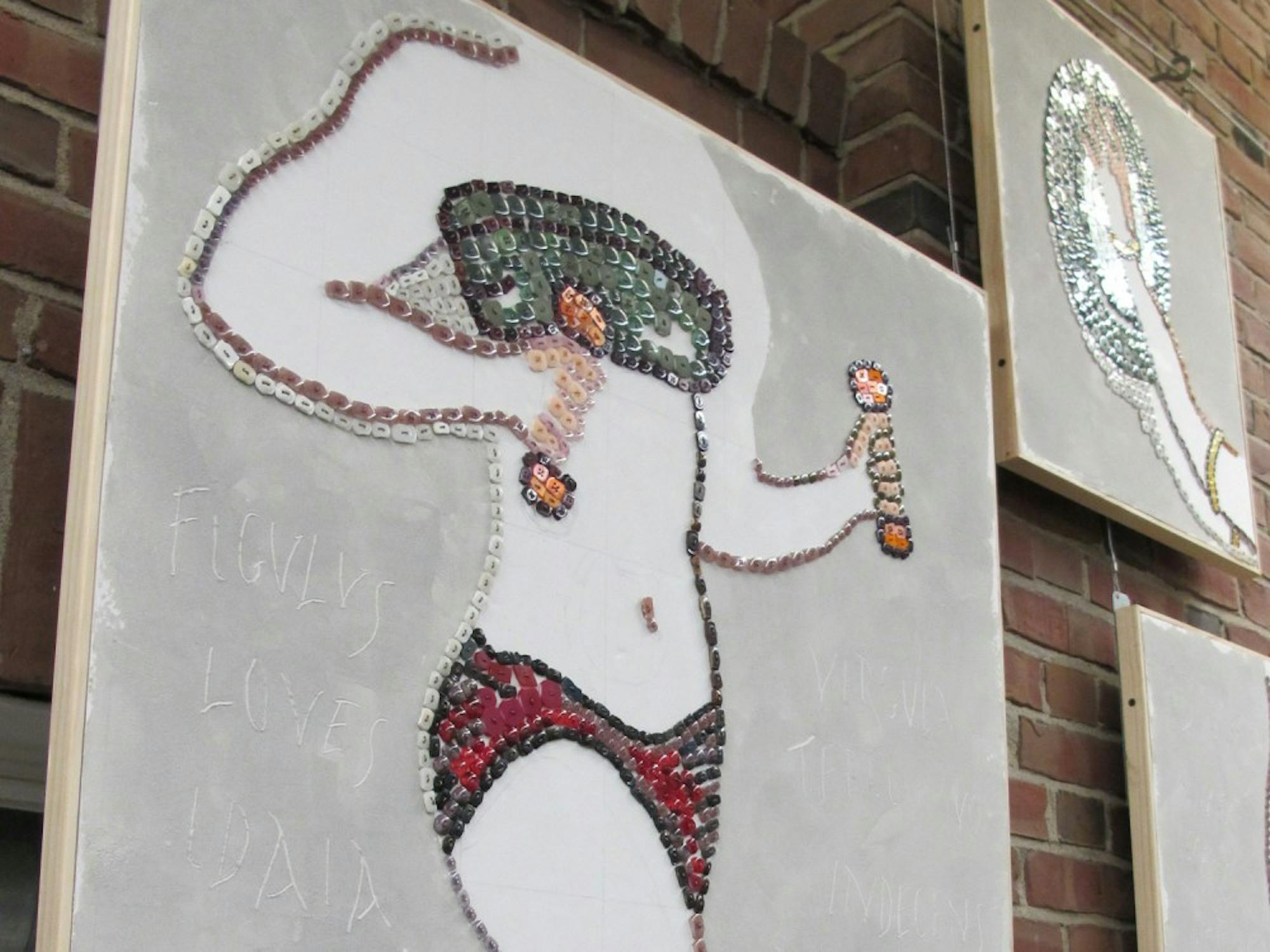Most students probably haven’t stopped to think about the mosaics on the first floor of Berry library. To some, the mosaics are a bewildering object, funny or simply an unnoticed adornment. A few people will read the sign or watch part of the six-minute documentary set up on a consul next to the mosaics.
The temporary exhibit by Angela Lorenz, titled “Elite Olympic Champions as Dancing Bikini Girls,” is an interpretation of Roman mosaics from 300 A.D using buttons.
In honor of the mosaics’ premiere here, the companion artist’s book features a Dartmouth pendant. Lorenz’ work is currently in more than 100 collections across the world.
The Berry brickway space was first used as a gallery for an exhibit in 2007 by artist Wenda Gu, dean of libraries Jeffrey Horrell said. The wires left up from that exhibit were then used in further short term exhibits.
“It’s such a public space and literally hundreds if not thousands of people a day walk through there,” Horrell said. “It’s a place where people can view things that they ordinarily might not view. Sometimes you might have to go to museum, but here it’s very public art.”
Lorenz, who splits her time between Bologna, Italy and Maine, completed the panels featuring headless women participating in Olympic events over three summers.
The mosaics are adorned with graffiti taken from the archaeological site and former Roman city Herculaneum and the grids are left up on the intentionally blank parts of the bodies.
“People are always going to be entertained by bikinis and that’s not a bad thing,” Lorenz said. “I cut off the heads and the bikinis are very evident and fun. They’re going to draw you into the work. They’re simplified and you’re a little disoriented about what’s going on. Allows us to refocus our gaze and look at their athletic equipment ”
The project is based on research published by Italian archeologist Isabella Baldini Lippolis on mosaics from 300 A.D. Lorenz first saw the mosaics in tourist pamphlets, where the women were misinterpreted as dancing musicians, and visited the originals in 1998.
“The idea that women from the most elite Roman families had a goal to compete in Olympics in different Roman cities is pretty impressive,” Lorenz said. “When I discovered these mosaics from 300 A.D. of athletes that were interpreted as dancing musicians for over 100 years was kind of outrageous for me. I wanted to bring this notion to a wider public and give them their dignity back.”
As the youngest of five children all involved in athletics, Lorenz could not imagine that women had different activities.
“I never thought I would not be able to do any different activities or that some were more appropriate for girls,” she said. “My brothers didn’t let me do ballet or play with dolls. They drowned my dolls in the bathtub.”
The mosaics are made with buttons and hairpins, materials usually associated with women’s work. These buttons draw in viewers including Dale Bellitto ’16, who came to the talk on the suggestion of an art history professor.
“I had walked past the murals and had no idea what they were,” Bellitto said. “It struck me that they were made with buttons, the material was really interesting to me as well as what it’s trying to say about women. I was not exactly sure what she’s trying to say and that’s why I came to find out.”
Another draw of the work is its title, a pun on Victoria’s Secret.
“The titles of my works very often have puns or plays on words,” Lorenz said. “Humor is very important, and it helps draw people in. But they also work as a pneumonic, so I myself can remember what I studied. Some scholars have noted that what I do is create little theaters of memory.”
While Lorenz described the conceptual reasons behind her artistic choices, such as the use of buttons or the headlessness of the figures, understanding that background is not essential for the artist.
“I don’t think you have to know any of this stuff,” she said. “I’m happy if you just look at my work with the eyes of a child... My work is very conceptual and layered. But if it stops you in your tracks and makes you forget your worries for a minute then it’s all worth it.”
“Elite Olympic Champions as Dancing Bikini Girls” is on display until Dec. 1. Lorenz’s talk was organized by director of education and outreach Laura Barrett and was sponsored by Baker-Berry Library as well as Friends of the Library.
This article has been revised to reflect the following correction
Correction: October 31, 2013
The original version of this article stated that Lorenz's work is found in collections across the nation when in fact her work has been featured internationally as well.




